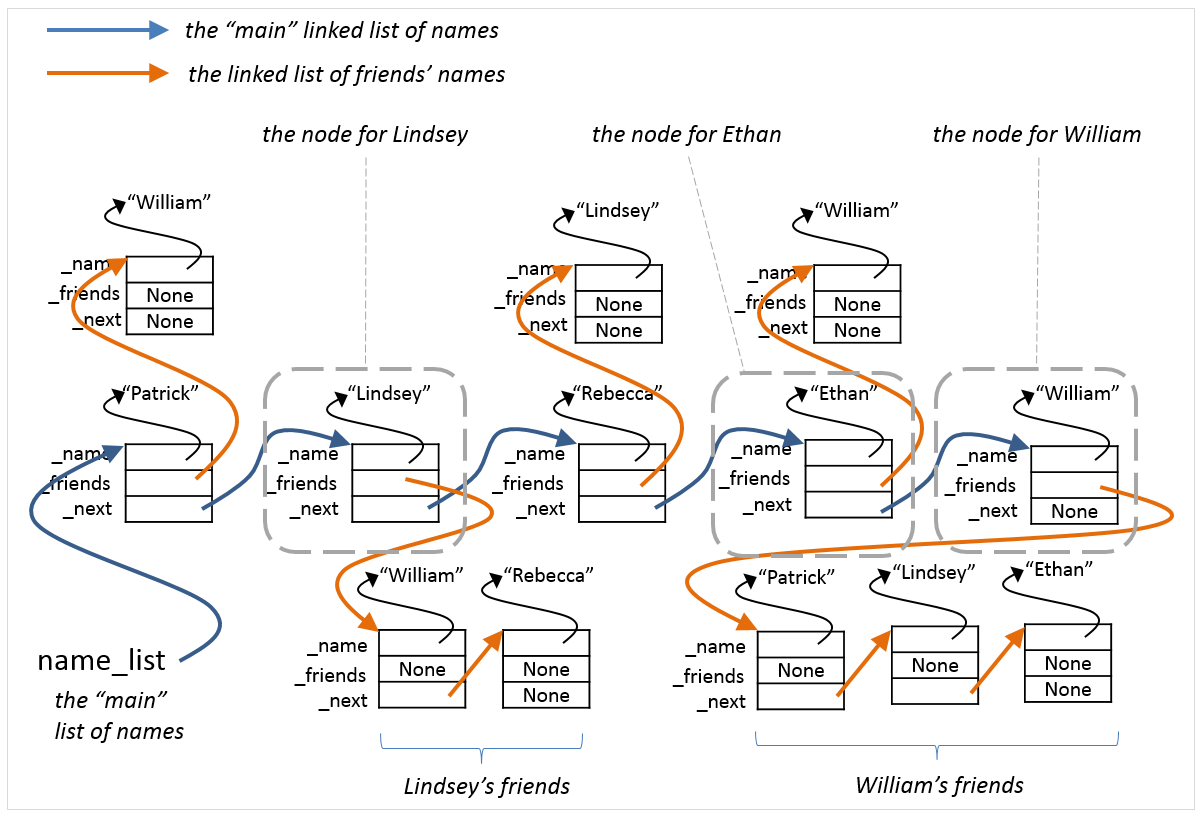
CSc 120: Friends
The primary purpose of this problem is to continue working with linked lists.
Restrictions
-
For the long problems, your code should follow the style guidelines
for the class.
-
You may not use concepts and/or short-hand syntax not yet covered in class. The restrictions include the following:
-
list (or dictionary) comprehensions, e.g., [n * 2 for i in range(10)]
-
with open (explicitly open and close the file instead)
-
the ternary operator (use an if instead)
-
nested functions (using def within a function to define another function)
-
recursion
-
exceptions and asssertions
-
type annotations
-
lambda expressions
-
generators and user defined iterators
-
default arguments
-
importing libraries, unless a library is explicity allow in the specification
-
New restriction: Using try/except to avoid having to check for None when iterating through a linked list is banned.
Background
Social media sites often look at what you have in common with your
friends (or followers, or contacts) to make suggestions. As an example,
Facebook and LinkedIn will point out "mutual friends", i.e.,
people whose friends have one or more people in common with yours.
This problem involves implementing a simple form of an algorithm for
identifying such mutual friends.
Expected Behavior
Write a Python program, in two files linked_list.py and
friends.py, that behaves as specified below.
The file linked_list.py should contain code implementing
the LinkedList and associated classes while
friends.py should contain code that uses these classes
to implement the functionality required of this program. At the top your
friends.py file, include the following statement so that you are able to use the classes in your linked list file:
from linked_list import *
Your program should behave as follows.
-
Read in the name of an input file using input('Input file: ').
Read in the contents of this file into your program.
-
The data in the file specifies friendship relationships between pairs of
names. Organize the data into the linked list structure specified under Data structures below.
NOTE: Friendships are two-way relations (in mathematics, such relations
are called
symmetric). This means that for each input line
of the form
X Y
you should set up your data structures to indicate two things:
-
X is a friend of Y; and
-
Y is a friend of X.
-
Read in two names using the function calls below. You can use other variable names
or your choice to store the values read in. Strip off whitespace as necessary.
name1 = input('Name 1: ')
name2 = input('Name 2: ')
-
If there are friends in common, first print the following line:
Friends in common:
Then print out the name of each mutual friend of name1 and
name2, i.e., any name3 such that
name3 is a friend of both name1 and
name2 (see Output format below). Names must be printed in alphabetical order.
If there are no friends in common, no further output is produced. (That is, if there are no
friends in common, the program only produces the input prompts.)
Input format
Each line in the input file consists of two strings separated by whitespace
(blanks and tabs). E.g.: the file
in04.txt is:
William Ethan
Rebecca Lindsey
William Lindsey
William Patrick
You should not make assumptions about the amount of whitespace around and
between names.
Output format
If there are friends in common, first print the following line:
Friends in common:
Then print out the name of each mutual friend in alphabetical order.
If there are no friends in common, no further output is produced. (That is, if there are no
friends in common, the program only produces the input prompts and does NOT print Friends in common:. )
Data Structures
The names read in should be organized as a linked list with a
node per name.
Each node should have the following attributes:
-
a name (a string);
-
the friends for that name (a linked list); and
-
a reference to the next node.
For example, for the file in04.txt
mentioned above (under Input format), the data structure should
be as shown below:

(click on the image for a larger picture)
Programming Requirements
As you read in a line of the friendship data from the input file, you will strip and split the line.
This is the only time that you can use a Python list in your solution. For each name, you must
determine if the name is already in the "main" linked list of names and add it if not (as a node).
In addition, add the name (as a node) to its friends linked list.
Your program must use linked lists to implement all of the following
tasks:
-
the names read in from the input file (which go into the "main" linked list)
-
for each such name, the list of that person's friends
-
the friends in common between two people
-
sorting the common friends alphabetically for printing
Your code should be organized among your files as follows:
-
linked_list.py: Code to implement the
linked list class.
-
friends.py: Code that uses methods from
the linked list class to implement the application required by
this assignment.
The methods defined in linked_list.py can be accessed
in friends.py using an import statement
in the latter file.
Errors
You must check for the following error:
One of the names name1 or name2
cannot be found in the list of names. (Read in both names first. Check for name1 first and name2 second. At most one name will be unkown.)
Program behavior:
Give the following error message and stop processing further.
Error message:
"ERROR: Unknown person " + name
Examples
Some examples are shown
here.

